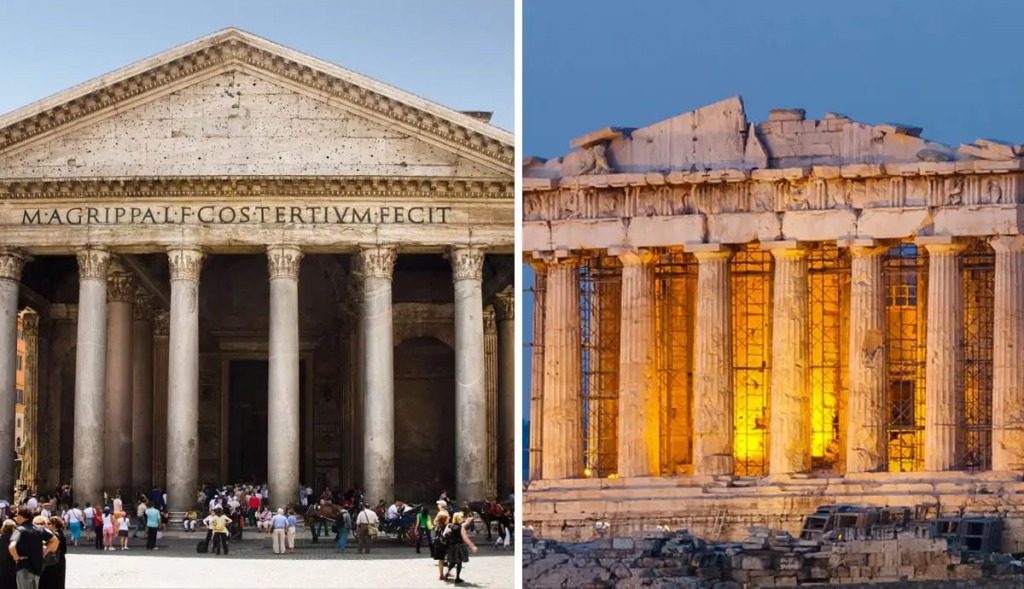
The Parthenon in Athens and the Pantheon in Rome are two iconic architectural marvels that exemplify the distinctive styles and functions of their respective ancient Greek and Roman cultures. These structures not only showcase the exceptional craftsmanship and architectural prowess of their time but also reflect the values, beliefs, and societal norms prevalent in their societies. In this essay, we will explore how the style and function of each building serve as a typical example of its culture while highlighting the similarities and differences between ancient Greece and Rome.
The Parthenon; A Testament to Greek Culture:
The Parthenon, constructed between 447 and 438 BCE, stands as a testament to the Golden Age of Athens and the glory of ancient Greece (Britannica.com, 2023). This temple, dedicated to the goddess Athena, exhibits the refined and harmonious architectural style known as Classical Greek architecture. The Parthenon’s use of the Doric order, with its sturdy columns and restrained ornamentation, reflects the Greeks’ emphasis on balance, proportion, and simplicity.
The function of the Parthenon was primarily religious, serving as a place of worship and the treasury of the Delian League (Britannica.com, 2023). The friezes and metopes depicted mythological scenes, celebrating the achievements and virtues of the gods and heroes. Symbolically, the Parthenon represented the power, wealth, and cultural achievements of Athens, reinforcing the city-state’s identity as the cradle of democracy and the birthplace of philosophy, arts, and sciences.
The Pantheon; A Reflection of Roman Culture:
In stark contrast to the Parthenon, the Pantheon in Rome, completed in 128 CE, exemplifies the grandeur and engineering prowess of ancient Rome (Ranogajec, 2015). The Pantheon’s architectural style, known as Roman Imperial architecture, combines elements of Greek and Etruscan influences with Roman innovation. The most distinctive feature of the Pantheon is its massive dome, which symbolizes Roman engineering ingenuity and their pursuit of architectural perfection.
The function of the Pantheon evolved over time. Initially, it served as a temple dedicated to the Roman gods, with its interior adorned with statues and altars. However, after the rise of Christianity, the Pantheon was converted into a church in the 7th century CE (Ranogajec, 2015). The transition from a pagan temple to a Christian place of worship reflects the Romans’ ability to adapt and incorporate different cultural and religious influences.
Similarities and Differences:
While both the Parthenon and the Pantheon were religious structures, their architectural styles and functions reveal contrasting aspects of ancient Greek and Roman cultures. The Parthenon embodies the Greek ideals of balance, simplicity, and intellectual pursuit, reflecting their focus on philosophy, democracy, and the pursuit of knowledge. On the other hand, the Pantheon represents Roman engineering prowess, grandeur, and adaptability, reflecting their emphasis on power, conquest, and assimilation.
In terms of similarities, both structures exhibit the use of columns, with the Parthenon utilizing the Doric order and the Pantheon incorporating Corinthian columns. Additionally, both buildings display meticulous attention to detail and craftsmanship, showcasing the technical skills of their respective cultures.
Conclusion
The Parthenon and the Pantheon stand as architectural masterpieces that encapsulate the essence of ancient Greek and Roman cultures. The Parthenon’s classical simplicity and religious significance are emblematic of the Greek emphasis on balance, knowledge, and democracy. In contrast, the Pantheon’s grandeur, engineering marvel, and adaptability reflect the Roman focus on power, conquest, and assimilation.
These two buildings serve as enduring symbols of their civilizations, immortalizing the values, beliefs, and achievements of ancient Greece and Rome. Through their architecture, the Parthenon and the Pantheon continue to inspire awe and admiration, allowing us to appreciate the rich cultural heritage of these great ancient civilizations.
Word count: 597.
References
Britannica.com. (n.d.). Parthenon. Retrieved from https://www.britannica.com/topic/Parthenon
Ranogajec, P. (2015, December 11). The Pantheon (Rome), in Smarthistory, retrieved from https://smarthistory.org/the-pantheon/
